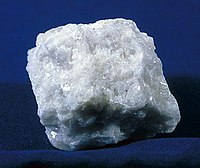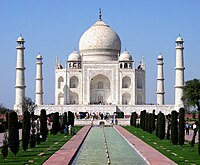For other uses, see Marble (disambiguation).
Marble is a metamorphic rock composed of recrystallized carbonate minerals, most commonlycalcite or dolomite.
Geologists use the term "marble" to refer to metamorphosed limestone; however stonemasons use the term more broadly to encompass unmetamorphosed limestone.[1]
Contents[hide] |
[edit]Etymology
The word "marble" derives from the Greek "μάρμαρον" (mármaron),[2] from "μάρμαρος" (mármaros), "crystalline rock", "shining stone",[3][4] perhaps from the verb "μαρμαίρω" (marmaírō), "to flash, sparkle, gleam".[5] This stem is also the basis for the English word marmoreal, meaning "marble-like."
Whilst the English term resembles the French marbre, most other European languages (e.g. Spanishmármol, Italian marmo, Portuguese mármore, German, Norwegian and Swedish marmor, Dutchmarmer, Polish marmur, Turkish mermer, Czech mramor and Russian мрáмор ) follow the original Greek.
[edit]Physical origins
Marble is a rock resulting from metamorphism of sedimentary carbonate rocks, most commonlylimestone or dolomite rock. Metamorphism causes variable recrystallization of the original carbonate mineral grains.
The resulting marble rock is typically composed of an interlocking mosaic of carbonate crystals. Primary sedimentary textures and structures of the original carbonate rock (protolith) have typically been modified or destroyed.
Pure white marble is the result of metamorphism of a very pure (silicate-poor) limestone or dolomite protolith. The characteristic swirls and veins of many colored marble varieties are usually due to various mineral impurities such as clay, silt, sand, iron oxides, or chert which were originally present as grains or layers in the limestone.
Green coloration is often due to serpentine resulting from originally high magnesium limestone or dolostone with silica impurities. These various impurities have been mobilized and recrystallized by the intense pressure and heat of the metamorphism.
[edit]Types
Examples of historically notable marble varieties and locations:
[edit]Uses
[edit]Sculpture
White marble has been prized for its use in sculptures since classical times. This preference has to do with its softness, relative isotropy and homogeneity, and a relative resistance to shattering. Also, the low index of refraction of calcite allows light to penetrate several millimeters into the stone before being scattered out, resulting in the characteristic waxy look which gives "life" to marble sculptures of the human body.
[edit]Construction marble
Construction marble is a stone which is composed of calcite, dolomite or serpentine which is capable of taking a polish.[7] More generally inconstruction, specifically the dimension stone trade, the term "marble" is used for any crystalline calcitic rock (and some non-calcitic rocks) useful as building stone. For example, Tennessee marble is really a dense granular fossiliferous gray to pink to maroon Ordovician limestone that geologists call the Holston Formation.
[edit]Production
According to the United States Geological Survey, U.S. dimension marble production in 2006 was 46,400 tons valued at $18.1 million, compared to 72,300 tons valued at $18.9 million in 2005. Crushed marble production (for aggregate and industrial uses) in 2006 was 11.8 million tons valued at $116 million, of which 6.5 million tons was finely ground calcium carbonate and the rest was construction aggregate. For comparison, 2005 crushed marble production was 7.76 million tons valued at $58.7 million, of which 4.8 million tons was finely ground calcium carbonate and the rest was construction aggregate. U.S. dimension marble demand is about 1.3 million tons. The DSAN World Demand for (finished) Marble Index has shown a growth of 12% annually for the 2000–2006 period, compared to 10.5% annually for the 2000–2005 period. The largest dimension marble application is tile.
[edit]Artificial marble
Marble dust is combined with cement or synthetic resins to make reconstituted or cultured marble. The appearance of marble can be simulated with faux marbling, a painting technique that imitates the stone's color patterns.
[edit]Cultural associations
As the favorite medium for Greek and Roman sculptors and architects (see classical sculpture), marble has become a cultural symbol of tradition and refined taste. Its extremely varied and colorful patterns make it a favorite decorative material, and it is often imitated in background patterns for computer displays, etc.
Places named after the stone include Marblehead,Ohio; Marblehead, Massachusetts; Marble Arch, London; the Sea of Marmara; India's Marble Rocks; and the towns of Marble, Minnesota; Marble, Colorado; andMarble Hill, Manhattan, New York. The Elgin Marblesare marble sculptures from the Parthenon that are on display in the British Museum. They were brought to Britain by the Earl of Elgin.
[edit]See also
- Cultured marble, marble powder with a binder.
- International Association of Marble, Slate and Stone Polishers, Rubbers and Sawyers, Tile and Marble setters' Helpers and Marble Mosaic and Terrazzo Workers' Helpers
- faux marbling, painting surfaces to look like marble.
- Marble sculpture
- Paper marbling
- Pietra dura, inlaying with marble and other stones.
- Scagliola, imitating marble with plasterwork.
- Verd antique – sometimes (erroneously) called "serpentine marble"
[edit]References
- ^ Kearey, Philip (2001). Dictionary of Geology, Penguin Group, London and New York, p. 163. ISBN 978-0-14-051494-0
- ^ μάρμαρον, Henry George Liddell, Robert Scott, A Greek-English Lexicon, on Perseus Digital Library
- ^ μάρμαρος, Henry George Liddell, Robert Scott, A Greek-English Lexicon, on Perseus Digital Library
- ^ Marble, Compact Oxford English Dictionary
- ^ μαρμαίρω, Henry George Liddell, Robert Scott, A Greek-English Lexicon, on Perseus Digital Library
- ^ http://www.britannica.com/EBchecked/topic/450431/Pentelic-marble
- ^ Marble Institute of America pp. 223 Glossary
[edit]External links
| Wikimedia Commons has media related to: Marble |
- Dimension Stone Statistics and Information – United States Geological Survey minerals information for dimension stone
- Learning to carve by Marc Levoy.
- USGS 2005 Minerals Yearbook: Stone, Crushed
- USGS 2005 Minerals Yearbook: Stone, Dimension
- USGS 2006 Minerals Yearbook: Stone, Crushed
- USGS 2006 Minerals Yearbook: Stone, Dimension
| ||||||||||||||||||||






No comments:
Post a Comment